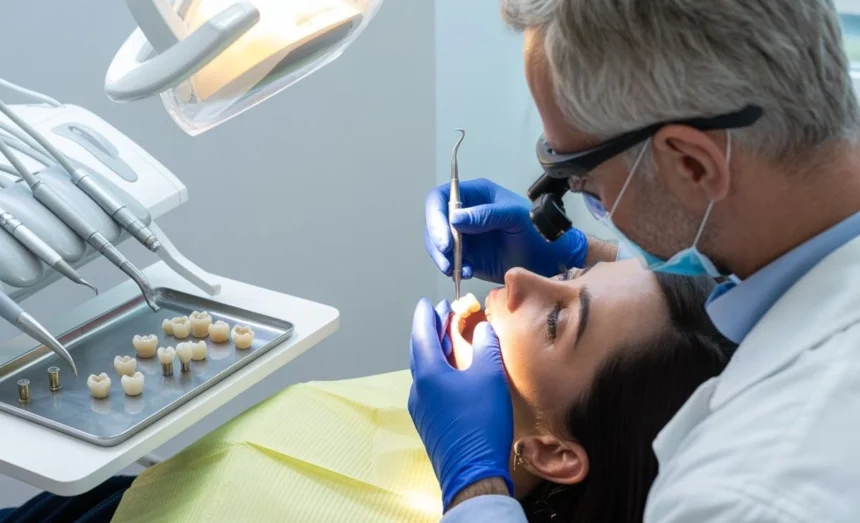Restorative dentistry repairs and replaces teeth damaged by decay, injury, or wear and tear, aiming to restore both function and appearance. This guide explains what restorative dentistry is, its goals, common procedures, benefits, and future advancements, helping you understand how it can maintain a healthy smile.
What is Restorative Dentistry?
Restorative dentistry is a branch of dentistry dedicated to diagnosing and treating diseases of the teeth and their supporting structures. Its primary goal is to restore the function, integrity, and aesthetics of a patient’s smile. Think of it as the art and science of repairing what’s broken. This can involve anything from filling a simple cavity to replacing a missing tooth with a sophisticated implant.
The field is broad and often works in conjunction with other dental specialties, such as cosmetic dentistry and prosthodontics. While cosmetic dentistry focuses mainly on improving the appearance of teeth, restorative dentistry ensures they work correctly for biting, chewing, and speaking. A well-restored tooth is not only beautiful but also strong and functional.
This area of dental care is crucial for people of all ages. Children may need fillings to combat early decay, and for them, specialized care from pediatric dentists like those in Oregon City can make a significant difference in their long-term oral health. Adults and seniors often require more complex procedures like crowns, bridges, or dentures to address issues that accumulate over a lifetime.
Key Principles and Objectives
Restorative dentistry is guided by a few core principles. The ultimate aim is to improve a patient’s quality of life by restoring their oral health.
The Main Goals
- Preserving Natural Teeth: The top priority is always to save a natural tooth whenever possible. Procedures like fillings, crowns, and root canals are designed to repair damage and prevent the need for extraction.
- Restoring Function: A healthy mouth allows you to eat and speak without pain or difficulty. Restorative procedures rebuild teeth so they can withstand the forces of chewing and contribute to clear speech.
- Improving Aesthetics: While function is paramount, a beautiful smile is also a key objective. Modern materials and techniques allow dentists to create restorations that look completely natural and blend seamlessly with existing teeth.
- Preventing Future Problems: By addressing current issues like decay or cracks, restorative treatments help prevent more serious problems from developing down the line. A simple filling today can prevent the need for a root canal tomorrow.
Common Restorative Procedures
Dentists have a wide range of tools and techniques to restore damaged teeth. The right procedure depends on the extent of the damage and the patient’s specific needs.
Dental Fillings
Fillings are one of the most common restorative treatments. When a tooth has a cavity, the dentist removes the decayed portion and fills the space with a durable material. Common materials include composite resin (which can be matched to the tooth’s color), amalgam (silver), and gold.
Crowns
A dental crown, or cap, is a custom-made covering that fits over an entire tooth. Crowns are used when a tooth is extensively damaged, weakened by a large filling, or after a root canal. They restore the tooth’s shape, size, strength, and appearance. Materials like porcelain, ceramic, and metal alloys are used to create crowns that are both strong and natural-looking.
Bridges
A dental bridge is used to replace one or more missing teeth. It consists of one or more artificial teeth (called pontics) held in place by crowns on the adjacent natural teeth. Bridges “bridge the gap” left by missing teeth, restoring the smile’s appearance and preventing neighboring teeth from shifting out of position.
Dental Implants
Implants are considered the gold standard for replacing missing teeth. An implant is a small titanium post that is surgically placed into the jawbone, where it acts as a new tooth root. Once it has fused with the bone, a custom crown is attached to the implant. Implants provide a stable, long-lasting solution that looks and feels like a natural tooth.
Dentures
Dentures are removable appliances that replace multiple missing teeth. A partial denture is used when some natural teeth remain, while a complete denture replaces all the teeth in an upper or lower arch. Modern dentures are more comfortable and natural-looking than ever before, offering a reliable solution for extensive tooth loss.
Root Canal Therapy
When decay or an injury reaches the inner pulp of a tooth, it can cause a painful infection. Root canal therapy involves removing the infected pulp, cleaning and disinfecting the inside of the tooth, and then filling and sealing it. The procedure saves the natural tooth from extraction and relieves the pain associated with the infection.
Advancements in Restorative Techniques
Restorative dentistry is constantly evolving, with new technologies and materials making treatments more effective, comfortable, and efficient.
- Digital Dentistry (CAD/CAM): Computer-aided design and computer-aided manufacturing (CAD/CAM) technology allows dentists to design and create restorations like crowns and bridges in a single appointment. This eliminates the need for temporary restorations and multiple visits.
- Laser Dentistry: Lasers are being used for a variety of restorative procedures, including cavity detection, removing decayed tooth structure, and preparing teeth for fillings. Laser treatments are often less invasive and can reduce the need for anesthesia.
- Improved Materials: Modern dental materials, such as advanced composite resins and ceramics, are stronger and more aesthetically pleasing than their predecessors. These materials allow for restorations that are virtually indistinguishable from natural teeth.
Conclusion
Restorative dentistry plays a vital role in maintaining oral health and function throughout a person’s life. From simple fillings to complex dental implants, these procedures repair damage, replace missing teeth, and help preserve a healthy, confident smile.







